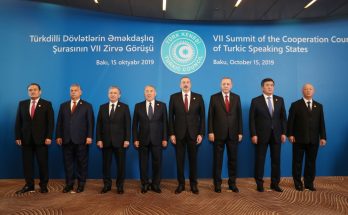
The Co-Chairs of the OSCE Minsk Group (ambassadors Igor Popov of Russia, James Warlick of the US, and Pierre Andrieu of France), together with the personal representative of the OSCE chairperson-in-office, ambassador Andrzej Kasprzyk, traveled to Azerbaijan’s occupied Nagorno-Karabakh region October 23-25, 2016, according to the statement by the OSCE MG posted on its website.
The co-chairs met with the presidents and foreign ministers of Azerbaijan and Armenia, Armenia’s newly appointed defense minister, and de facto authorities in Nagorno-Karabakh to discuss the situation after the unprecedented violence last April, and to clarify positions on the negotiation process, said the statement.
“During the meetings, the sides confirmed that the situation on the ground remains relatively calm,” said the statement. “The co-chairs underscored that respect for the ceasefire provides a critical foundation for ongoing negotiations, and stressed the importance of fully implementing decisions taken in Vienna and St. Petersburg.”
According to the statement, the co-chairs also discussed current working proposals to advance substantive negotiations towards a lasting peace.
“The presidents each expressed their views on how to move the settlement process forward,” the statement said. “The presidents also reaffirmed their agreement to expand the Office of the Personal Representative of the OSCE Chairperson-in-Office, and operational details are still being discussed.”
The co-chairs added that they plan to meet with the ministers including on the margins of the December 2016 OSCE Ministerial Council meeting in Hamburg to discuss a possible meeting of the presidents at the earliest opportunity.
“Such a dialogue at the highest level is necessary to make progress towards a settlement,” said the statement.
“While in the region, the Co-Chairs also met with the International Committee of the Red Cross (ICRC) to discuss the work the organization has undertaken on the exchange of data on missing persons, a humanitarian measure which the Co-Chairs have fully supported in meetings with officials at all levels,” the statement said.
The Nagorno-Karabakh conflict entered its modern phase when the Armenian SRR made territorial claims against the Azerbaijani SSR in 1988.
A fierce war broke out between Azerbaijan and Armenia over the Nagorno-Karabakh region of Azerbaijan. As a result of the war, Armenian armed forces occupied some 20 percent of Azerbaijani territory which includes Nagorno-Karabakh and seven adjacent districts (Lachin, Kalbajar, Aghdam, Fuzuli, Jabrayil, Gubadli and Zangilan), and over a million Azerbaijanis became refugees and internally displaced people.
The military operations finally came to an end when Azerbaijan and Armenia signed a ceasefire agreement in Bishkek in 1994.
Dealing with the settlement of the Nagorno-Karabakh conflict is the OSCE Minsk Group, which was created after the meeting of the CSCE (OSCE after the Budapest summit held in Dec.1994) Ministerial Council in Helsinki on 24 March 1992. The Group’s members include Azerbaijan, Armenia, Russia, the United States, France, Italy, Germany, Turkey, Belarus, Finland and Sweden.
Besides, the OSCE Minsk Group has a co-chairmanship institution, comprised of Russian, the US and French co-chairs, which began operating in 1996.
Resolutions 822, 853, 874 and 884 of the UN Security Council, which were passed in short intervals in 1993, and other resolutions adopted by the UN General Assembly, PACE, OSCE, OIC, and other organizations require Armenia to unconditionally withdraw its troops from Nagorno-Karabakh.
Apa.az




